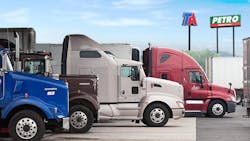Five fundamental truck care focal points
By Homer Hogg, TA Truck Service
Despite all the many advances in connected vehicle technology in recent years – developments that in many ways have turned big rigs into nothing short of rolling computers – trucks still rely on mechanical processes to move. And those “processes” require regular maintenance in order to operate effectively and with maximum efficiency. To that end, Homer Hogg, manager of technical development for TA Truck Service, offers five key maintenance areas truckers should focus on gleaned from his decades of experience in the tractor-trailer repair business.
Truckers work hard to control their maintenance costs. They are always looking for more efficient ways to maximize the life of every component on a truck, while keeping the truck on the road as much as possible. Some technologies – such as telematics – are helpful, but there is no substitute for tried and true maintenance practices.
Number one on my list is lubrication. With extended oil drain intervals comes the tendency to align the chassis lubrication with the oil change. But this trend must be carefully evaluated.
Certainly, extended life components are available, but they are not a silver bullet. For example, some u-joints installed on a truck from the factory have no grease fittings and are designed to run several hundred thousand miles trouble free. Yet many of these u-joints will eventually need to have a grease fitting installed and a normal lubrication regiment added. I’ve seen many failures of these u-joints as a result of the grease fittings never getting installed or the joints just failing as they reach the end of their lubrication life.
Extending the oil drain intervals will work under the right circumstances, but remember to get the moving parts on your truck lubricated at the correct interval. Many truckers perform a “dry” preventive maintenance or PM check between their oil changes primarily designed to get the vehicle lubricated properly.
Next is the cooling system. About 50% of major engine failures are due to poor coolant system maintenance.At one time, the trucking industry was mostly concerned about the freeze point of the antifreeze and the metals protection provided by the additives. Those concerns are still relevant, but antifreeze has become much more complex. Modern engines contain a higher amount of “lighter metals” such as aluminum and such metals are not always receptive to some of the chemicals traditionally added to coolants. Maintenance shops must understand which coolant is required and keep track of the condition of that coolant.
Aftertreatment systems have taken center stage in many maintenance shops. If your truck is losing coolant but no external leak can be located, it may be escaping through the exhaust system and making its way to the aftertreatment system. If that is happening, major damage could be the result. The costs to replace a damaged diesel particulate filter (DPF), for example, could be several thousand dollars.
Technicians must use diligence to determine the root cause of coolant loss and get the problem corrected before the truck suffers unscheduled downtime and costly aftertreatment repairs.
In addition, cleaning DPF filters must be part of your maintenance program, if you plan to keep the vehicle to and beyond the first required DPF cleaning cycle.
We now move on the tires, which have always been a concern due to the costs to replace them and the many factors that cause excessive tread wear. The number one tire care practice is proper air pressure. Matching the air pressure to the load is an important part of getting the most out of your tires and the tire manufacturers publish charts to help determine the proper air pressure required based on the load.
A good way to remember some of the key areas to focus on relative to tires is A.I.M.: Alignment, Inflation and Matching. “Align” the steer and drive tires; “inflate” your tires to match your load; and then “match” the height and design of the tire tread of each axle. Doing those three things will help you better control tire costs.
Finally, cranking and charging systems must be ready at all times. The good news is that these systems haven’t changed much in more than 40 years, nor have the maintenance practices needed to keep them trouble free.
Yet I am still amazed how many technicians across the trucking industry change batteries, alternators and starters and fail to check cables and connections. In fact, the majority of starter and alternator failures are a result of bad connections and corroded cables.
Once or twice a year you should test your cables and connections. This discipline alone will begin to drive down your costs and drive up your uptime.
While those five areas of truck maintenance noted above are not complex, they are critical to helping keep your truck operating costs control and on the road.

